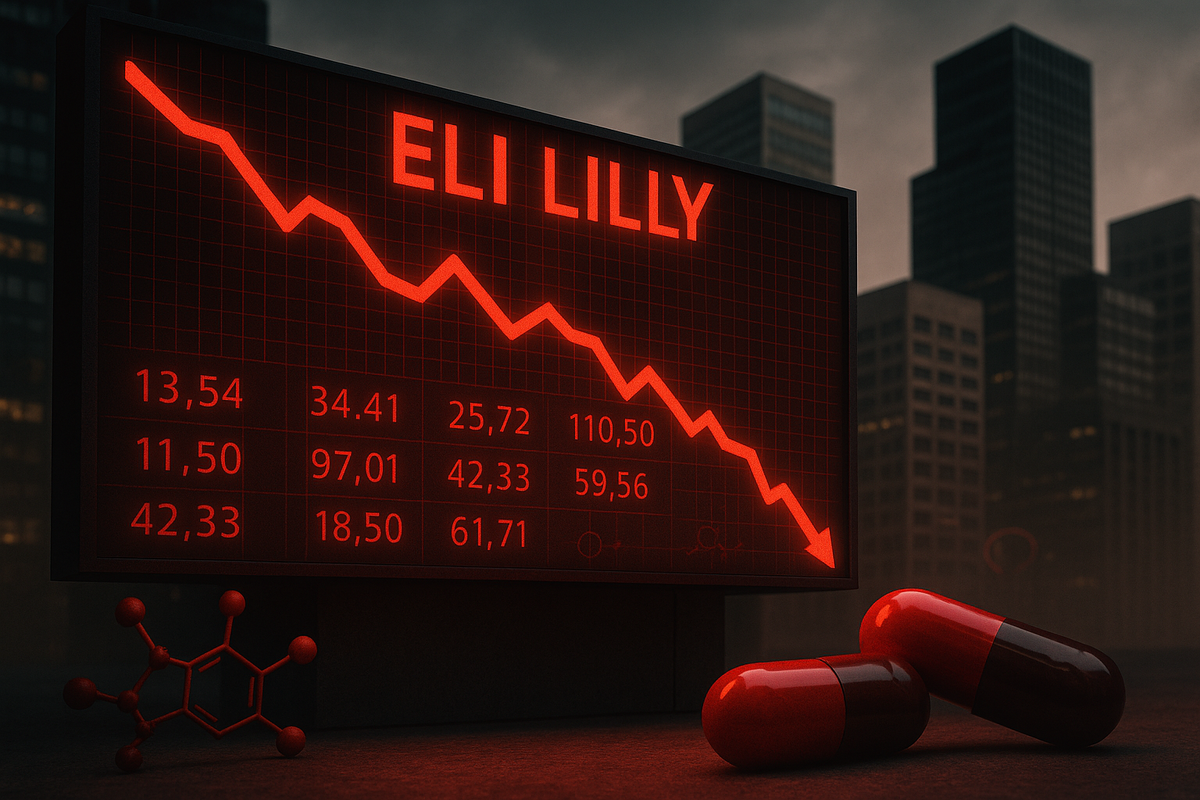Financial News
Eli Lilly Shares Tumble After Disappointing Weight-Loss Pill Data

Indianapolis, IN – Shares of pharmaceutical giant Eli Lilly and Company (NYSE: LLY) experienced a dramatic decline today, plummeting by more than 14% in early trading, wiping out approximately $98 billion to $100 billion from its market capitalization. The significant sell-off was triggered by the release of disappointing clinical trial data for its highly anticipated oral weight-loss pill, orforglipron. This setback overshadowed an otherwise robust second-quarter earnings report and an optimistic increased full-year outlook, highlighting the market's intense focus on the burgeoning obesity drug landscape.
The market's sharp reaction underscores the high stakes in the race for effective and convenient weight-loss treatments. While Eli Lilly's existing injectable obesity medicine, Zepbound (tirzepatide), continues to demonstrate strong growth, the less-than-stellar performance of its oral counterpart has raised questions about the company's ability to dominate all facets of this lucrative market.
Orforglipron's Performance Falls Short of Lofty Expectations
The core of Eli Lilly's stock woes lies in the Phase 3 trial results for orforglipron. Patients receiving the highest dose of the once-daily oral pill (36 milligrams) achieved an average weight loss of 12.4% over 72 weeks. While this represents a significant improvement over the placebo group's 0.9% loss, it fell short of Wall Street's ambitious expectations, which had anticipated a minimum weight loss in the range of 13.7% to 15%.
This outcome is particularly impactful when compared to Eli Lilly's own blockbuster injectable, Zepbound (NYSE: LLY), which has demonstrated an average weight loss of approximately 23% in trials. Similarly, Mounjaro (NYSE: LLY), which contains the same active ingredient as Zepbound (tirzepatide) and is approved for type 2 diabetes, has shown an average weight loss of 20.9%. The market had hoped for an oral alternative that could rival the efficacy of injectables, offering greater convenience and potentially broader patient access.
Furthermore, orforglipron's performance also trailed that of key rival Novo Nordisk's (CPH: NOVO B) oral weight-loss drug candidate (oral semaglutide), which helped trial participants lose about 15% of their body weight and has already been submitted for approval in the US. Novo Nordisk's injectable Wegovy (CPH: NOVO B) has also shown impressive results, with around 14% to 15% weight loss in trials. The trial also noted that the rate of side effects, including nausea, vomiting, and diarrhea, was slightly worse than anticipated, though generally consistent with other GLP-1 drugs, with approximately 10% of patients dropping out due to adverse effects. No liver safety issues were observed.
The timeline leading up to this moment saw Eli Lilly heavily investing in its obesity pipeline, with orforglipron positioned as a crucial component of its long-term strategy to capture a significant share of the rapidly expanding weight-loss market. The initial market reaction was swift and brutal, marking Eli Lilly's worst single-day stock performance in 26 years, despite the company's strong overall financial performance in the second quarter, driven by soaring sales of Zepbound and Mounjaro.
Winners and Losers in the Obesity Drug Race
The immediate aftermath of Eli Lilly's announcement created clear winners and losers in the competitive pharmaceutical landscape. The most apparent beneficiary was Novo Nordisk (CPH: NOVO B), Eli Lilly's primary rival in the obesity market. Shares of the Danish pharmaceutical giant surged by as much as 14% on the news, as investors interpreted orforglipron's underwhelming data as a reduction in competitive pressure on Novo Nordisk's highly successful weight-loss franchises, Wegovy and its oral semaglutide candidate. This reinforces Novo Nordisk's strong position and potentially gives it more breathing room in the race for oral GLP-1 dominance.
On the losing side, Eli Lilly (NYSE: LLY) itself bore the brunt of the market's disappointment. Despite its robust existing portfolio and strong financial performance, the significant drop in its stock price reflects the market's high expectations for its pipeline and the premium placed on innovation in the obesity space. The company's valuation took a substantial hit, underscoring the volatility inherent in drug development and the market's unforgiving nature when highly anticipated results fall short.
Beyond the direct competitors, other smaller biotech companies with early-stage obesity drug candidates might also experience a ripple effect. Companies developing novel mechanisms of action or those with more promising early-stage oral GLP-1 data could see increased investor interest as the market re-evaluates the competitive landscape. Conversely, any company with a less differentiated or less effective oral weight-loss candidate might find it harder to attract funding or partnerships in the wake of Eli Lilly's experience, as investors become more discerning about the efficacy bar for new entrants. The event also highlights the challenges of translating injectable efficacy into an oral format, a hurdle that many pharmaceutical companies are attempting to overcome.
Industry Impact and Broader Implications
Eli Lilly's orforglipron data release is more than just a setback for one company; it sends significant ripples across the entire pharmaceutical industry, particularly within the burgeoning metabolic disease sector. This event underscores the immense challenge of developing highly effective and safe oral alternatives to established injectable therapies, especially in a market as competitive and scrutinized as weight loss. It reinforces the notion that while convenience is highly desirable, efficacy remains paramount for market leadership and investor confidence.
The outcome could lead to a re-evaluation of development strategies across the industry. Companies currently pursuing oral GLP-1 agonists or other oral weight-loss mechanisms may face increased pressure to demonstrate superior efficacy and a cleaner safety profile to justify their investments. This might lead to more rigorous trial designs, higher efficacy targets, and potentially a more cautious approach to pipeline announcements. Competitors and partners will be closely watching Eli Lilly's next steps, as its strategic pivots could influence the direction of the entire market. For instance, companies like Viking Therapeutics (NASDAQ: VKTX) or Amgen (NASDAQ: AMGN), which also have obesity candidates in their pipelines, will likely face renewed scrutiny regarding their own trial designs and expected outcomes.
From a regulatory perspective, while this specific event doesn't immediately trigger new policies, it highlights the FDA's continued emphasis on robust clinical data for novel weight-loss therapies. The bar for approval remains high, requiring not only significant weight reduction but also a manageable safety profile. Historically, the weight-loss drug market has been fraught with challenges, including safety concerns that led to withdrawals of drugs like fen-phen and sibutramine. This recent development serves as a reminder that even with promising mechanisms like GLP-1 agonism, the journey from discovery to market dominance is complex and fraught with potential pitfalls.
What Comes Next
In the short term, Eli Lilly will likely face continued pressure to articulate its strategy for orforglipron. While the initial data was disappointing, the company may choose to continue development, perhaps exploring different dosing regimens or combination therapies to enhance efficacy or mitigate side effects. The focus will undoubtedly shift back to maximizing the potential of Zepbound, which remains a powerhouse in the obesity market. Investors will be keenly watching for any updates on Zepbound's market penetration, manufacturing capacity, and potential label expansions.
Longer term, this event could prompt strategic pivots within Eli Lilly's R&D pipeline. The company might reallocate resources towards other promising candidates or accelerate the development of next-generation injectable therapies that offer even greater efficacy or convenience. The market opportunity in obesity is simply too vast to abandon, estimated to reach hundreds of billions of dollars annually. Eli Lilly will need to demonstrate its ability to innovate and adapt to maintain its competitive edge.
For the broader market, this development could intensify the race for the "holy grail" of obesity treatment: a highly effective, safe, and convenient oral pill. Companies with truly differentiated oral candidates will likely see increased investor interest. Conversely, those with less compelling data may struggle to secure funding or partnerships. Potential scenarios include increased M&A activity as larger players seek to acquire promising smaller biotechs, or a renewed focus on combination therapies that leverage different mechanisms to achieve superior weight loss. The challenge for all players will be to balance efficacy with patient tolerability and adherence, especially for a chronic condition like obesity.
Conclusion
The significant tumble in Eli Lilly's shares following the orforglipron data release serves as a stark reminder of the high-stakes nature of pharmaceutical innovation, particularly in the highly anticipated obesity market. While the company's existing obesity drug, Zepbound, continues its impressive trajectory, the disappointing performance of its oral counterpart highlights the formidable challenges in developing convenient yet highly efficacious treatments.
The key takeaway from this event is the market's unwavering demand for superior efficacy in weight-loss therapies, even when balanced against the convenience of an oral formulation. Eli Lilly's setback has undoubtedly bolstered the position of its primary rival, Novo Nordisk, in the immediate term.
Investors should closely monitor Eli Lilly's strategic response, including any adjustments to its pipeline priorities and its continued efforts to scale up Zepbound production. The broader industry will be watching for how other companies with oral obesity candidates react to this new benchmark. The race for the ultimate weight-loss solution continues, and while the path may be fraught with challenges, the immense unmet medical need ensures that innovation will persist, shaping the future of metabolic health for years to come. The coming months will reveal whether this is a temporary stumble for Eli Lilly or a more significant shift in the competitive dynamics of the lucrative obesity drug market.
More News
View More





Quotes delayed at least 20 minutes.
By accessing this page, you agree to the following
Privacy Policy and Terms Of Service.



